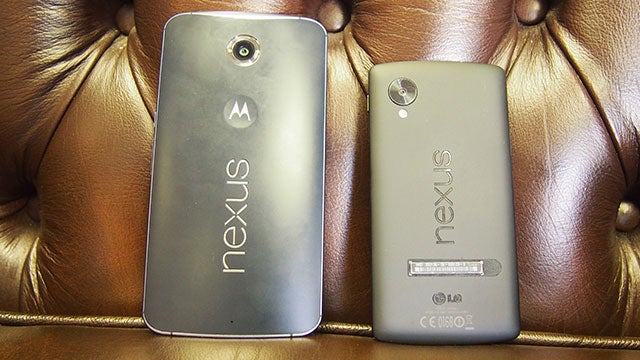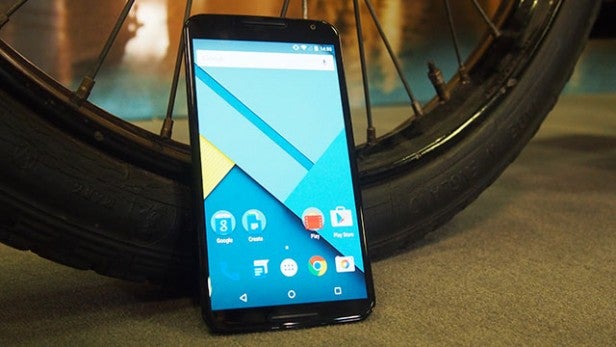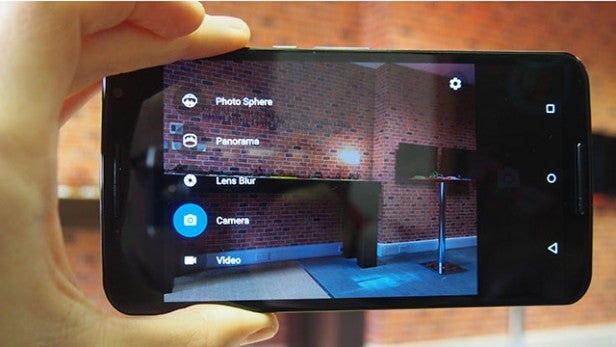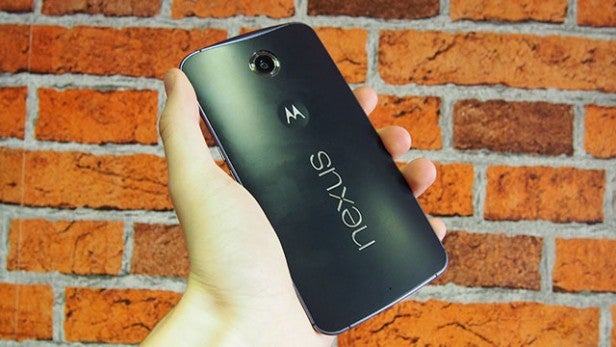Nexus 6 vs Nexus 5: What’s different?

How does the new Nexus compare to the LG Nexus?
Google has finally revealed the UK pricing for its new flagship smartphone, the Nexus 6. With the 32GB model costing £160 more than the equivalent Nexus 5, is it a worthwhile upgrade?
Until we get our hands on the Nexus 6 we can’t be certain, but we can take a look at how the two phones compare on paper.
Watch the Nexus 6 official announcement video
Nexus 6 vs Nexus 5: Design
Nexus 6: Aluminium frame, polycarbonate body, 10.06mm thick, 184g
Nexus 5: Plastic construction, 8.59mm thick, 130g
What’s immediately clear about these two phones is that they share surprisingly little beyond the Nexus name and access to stock Android.
While the Nexus 5 was made by LG, the Nexus 6 is made by Motorola, and that really tells in the final designs. While the Nexus 5 is the plainer device, its unadorned blank slate looks actually mark it out as quite different from anything else on the market.
The Nexus 6, by contrast, is more striking to look at, but it’s essentially just a larger version of the Moto X 2014. Original it ain’t.
In terms of the quality of the designs, however, the Nexus 6 is way out ahead. It’s got a classy metal frame, and a polycarbonate body coated (on the back) with a soft-touch plastic finish. Its curved back, which tapers to almost nothing at the sides, is distinctive and aids grippiness.
Of course, it needs that latter attribute, as the Nexus 6 is one chunky customer. It’s a good millimetre-and-a-half thicker than the Nexus 5, and a whopping 54g heavier.
The Nexus 6 is the more attractive design, then, but the Nexus 5 is the more practical.
SEE ALSO: iPhone 6 Plus vs iPhone 6

Nexus 6 vs Nexus 5: Screen
Nexus 6: 5.9-inch 2560 x 1440, QHD AMOLED (493ppi)
Nexus 5: 4.95-inch 1920 x 1080, IPS LCD (445ppi)
The reason the Nexus 6 is so much larger than the Nexus 5 lies with its screen, which at 5.9-inches is pretty much a whole inch bigger.
While the Nexus 5’s 4.95-inch display sports a still-decent 1920 x 1080 Full HD resolution, the Nexus 6 takes things to the next level of sharpness with a 2560 x 1440 QHD resolution. That makes for an even more pixel-dense display, with 493ppi comparing favourably to the Nexus 5’s 445ppi screen.
Both can be said to be nice and crisp for the their respective sizes, though.
Another major difference here is in the type of screen used. While the Nexus 5 has an IPS LCD display, making for a nicely balanced picture with accurate colours and decent visibility in all conditions, the Nexus 6 has a more advanced AMOLED display.
AMOLED screens feature superior colour contrast and deeper blacks than their LCD counterparts, but struggle to get the same crisp edges and colour accuracy. Over-saturated colours are the most common complaint here.
Samsung has managed to bring AMOLED’s wilder tendencies under control, but it remains to be seen if Motorola can do the same with the Nexus 6. It’s got the potential to be a stunner, though.

Nexus 6 vs Nexus 5: Camera
Nexus 6: 13MP, OIS, 1/3.06-inch sensor, f/2.0 aperture, dual-LED ring flash
Nexus 5: 8MP, OIS, 1/3.2-inch sensor, f/2.4 aperture, LED flash
Nexus cameras have always proved to be pretty weak. It seems as if this typically pricey component has been one of the first to be compromised in a bid to bring the final phone in at a decent price.
Last year’s Nexus 5 camera was the best yet – an 8-megapixel example with OIS. However, it was still arguably the weakest component of the whole package, and it certainly didn’t trouble the Android smartphone elite for image quality or consistency.
As we’ve touched upon already, the Nexus 6 isn’t being made with any such mid-range price point in mind. It’s a full-on flagship phone, and as such promises to provide the first truly decent Nexus camera yet.
It looks to be better than the Nexus 5 camera in every single way, with more pixels (13-megapixels, to be precise), a larger image sensor, a wider aperture, and a dual-LED flash arranged in a neat ring formation around the lens.

Nexus 6 vs Nexus 5: Performance
Nexus 6: 2.7GHz quad-core Snapdragon 805 processor, 3GB RAM, Adreno 420 GPU
Nexus 5: 2.26GHz quad-core Snapdragon 800 CPU, 2GB RAM, Adreno 330 GPU
Another area in which the Nexus 6 is clearly superior to its predecessor is power. Eschewing the minor upgrade over the Nexus 5’s Snapdragon 800 CPU that is the Snapdragon 801 (as found in the Samsung Galaxy S5 and the HTC One M8), the Nexus 6 skips straight to the Snapdragon 805. It might not sound like it’s very different, but this chip offers a considerable step forward in performance.
This is aided by a much better Adreno 420 GPU, so games and and HD video should be even smoother and more responsive – although of course, there’s all those extra pixels to push around on the Nexus 6’s QHD display, which should take a slight edge off its performance advantage. But only a slight one.
Finally, the Nexus 6 has 50 percent more RAM than its older counterpart, which should make it more future proof and more capable when it comes to intensive tasks and multitasking.

Nexus 6 vs Nexus 5: Software
Nexus 6: Android 5.0 Lollipop
Nexus 5: Android 5.0 Lollipop
There’s really not much to say here, as both Nexus phones will be running the same software soon. The Nexus 6 ships with Android 5.0 Lollipop out of the box, but the Nexus 5 will be one of the first phones to get the update from November 12.
Android 5.0 represents the biggest update for the Android OS in quite some time. It brings the gorgeous new Material Design, which treats UI elements almost like physical objects with their own mass and depth.
This results in a tactile experience where general navigation makes intuitive sense – and looks pretty to boot.
There’s also a new, more powerful multitasking system on board that allows for multiple tabs from within the same app – such as the inbox and an message draft in Gmail – and a new, more customisable heads-up notification system.

Nexus 6: Storage
Nexus 6: 32GB, 64GB; no microSD slot
Nexus 5: 16GB, 32GB; no microSD slot
Given that the Nexus 6 is positioned and priced as a premium phone, you’d jolly well hope that it would improve on the Nexus 5’s meagre storage.
While there are still only two storage options, they’re a step on from the 16GB and 32GB choices of the older phone. Here you get either 32GB or 64GB.
Given that there’s still a lack of microSD expansion (why, on such a large phone?), we’d have liked to have seen a 128GB option, but this is still a step forward for the range.

MORE: iPhone 6 vs Samsung Galaxy S5
Early Verdict
We haven’t reviewed the Nexus 6 yet, but we’re pretty confident it’s going to be good. How do we come to that conclusion?
Because we’ve already reviewed the Motorola Moto X 2014, of which the Nexus 6 bears more than a passing resemblance.
Yes, it’s been expanded to borderline tablet dimensions. But the Nexus 6 also appears to bring an improved camera (perhaps our biggest criticism of the Moto X) and a significant step forward in power.
Still, there’s no getting away from the fact that this is a crazily big phone. It will undoubtedly be too big for some people, in much the same way as the iPhone 6 Plus or the Samsung Galaxy Note 4 have proved to be.
That, along with the Nexus 6’s premium price point, is why we can’t declare it the outright winner here. The Nexus 5 remains just powerful enough and cheap enough to present a viable alternative for those who want a more discrete stock Android 5.0 experience.


